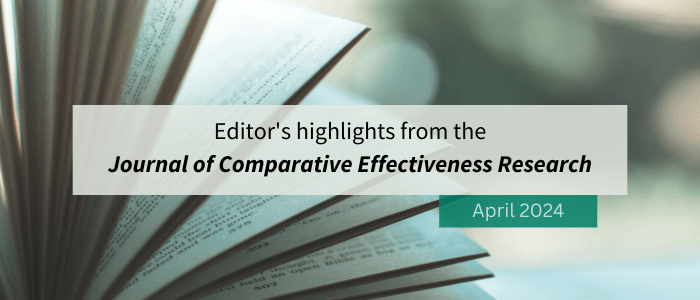Editor’s highlights from the Journal of Comparative Effectiveness Research – April 2024

Welcome to my monthly highlights from the Journal of Comparative Effectiveness Research (JCER), with my Editor’s picks from the April issue (Volume 13, Issue 4). This month’s content includes research on health economic outcomes across a variety of topics, including joint replacement surgery, hospitalization for COVID-19 and lower limb x-ray angiography.
In this monthly column, I share some of my Editor’s highlights from the latest issue of the Journal of Comparative Effectiveness Research (JCER), partner journal of The Evidence Base.
Use of interrupted time-series analyses in evaluating health economic outcomes following implementation of multilayer water-tight wound closure in a primary total joint arthroplasty population
Total joint arthroplasty is a surgical procedure that involves replacing a damaged or diseased joint, such as the hip or knee, with an artificial joint. This is a valuable treatment option that offers pain relief and improves motion and function in patients with joint problems. While the procedure has high survivorship and low morbidity and mortality, surgical site infection (SSI) is an important complication. In their Short Report, authors Tan et al. (Ethicon Inc., NJ, USA) describe their study comparing the clinical and economic outcomes of multi-layer, watertight wound closure versus conventional closure in total joint arthroplasty patients, assessing impact on outcomes such as hospital length of stay, discharge status, readmission rates and SSI rates.
Treatment of patients hospitalized for COVID-19 with remdesivir is associated with lower likelihood of 30-day readmission: a retrospective observational study
Decreasing stress on healthcare workers and the healthcare system remains an important priority as we recover from the considerable disruption caused by the pandemic. As people continue to be hospitalized for COVID-19, it is important that patients are managed appropriately with evidence-based therapies and prevent subsequent readmissions to minimize additional strain on both the healthcare system and patients. In this retrospective observational study, Mozaffari et al. (Gilead Sciences, CA, USA) investigate the association between remdesivir treatment during hospitalization for COVID-19 and the likelihood of 30-day readmission.
Digital variance angiography in patients undergoing lower limb arterial recanalization: cost–effectiveness analysis within the English healthcare setting
Digital variance angiography (DVA) is a recently developed image processing method used in angiography procedures, improving image quality compared to traditional methods. In their analysis, Ansaripour et al. (Optimax Access Ltd, The Netherlands), describe an economic model developed to assess the cost–effectiveness of DVA during x-ray angiography procedures when compared with existing imaging practice, from an English National Health Service (NHS) perspective.
You may also be interested in:
- ISPOR 2024: First look at the conference program
- Looking ahead to the GetReal Institute 2024 Annual Conference
- Observations from a first-time World EPA Congress 2024 attendee
In addition to my Editor’s picks from the April issue, you can read all the articles here, where all the articles are Open Access and freely available to read. The journal welcomes pre-submission enquiries, so do get in touch if you would be interested in contributing.
